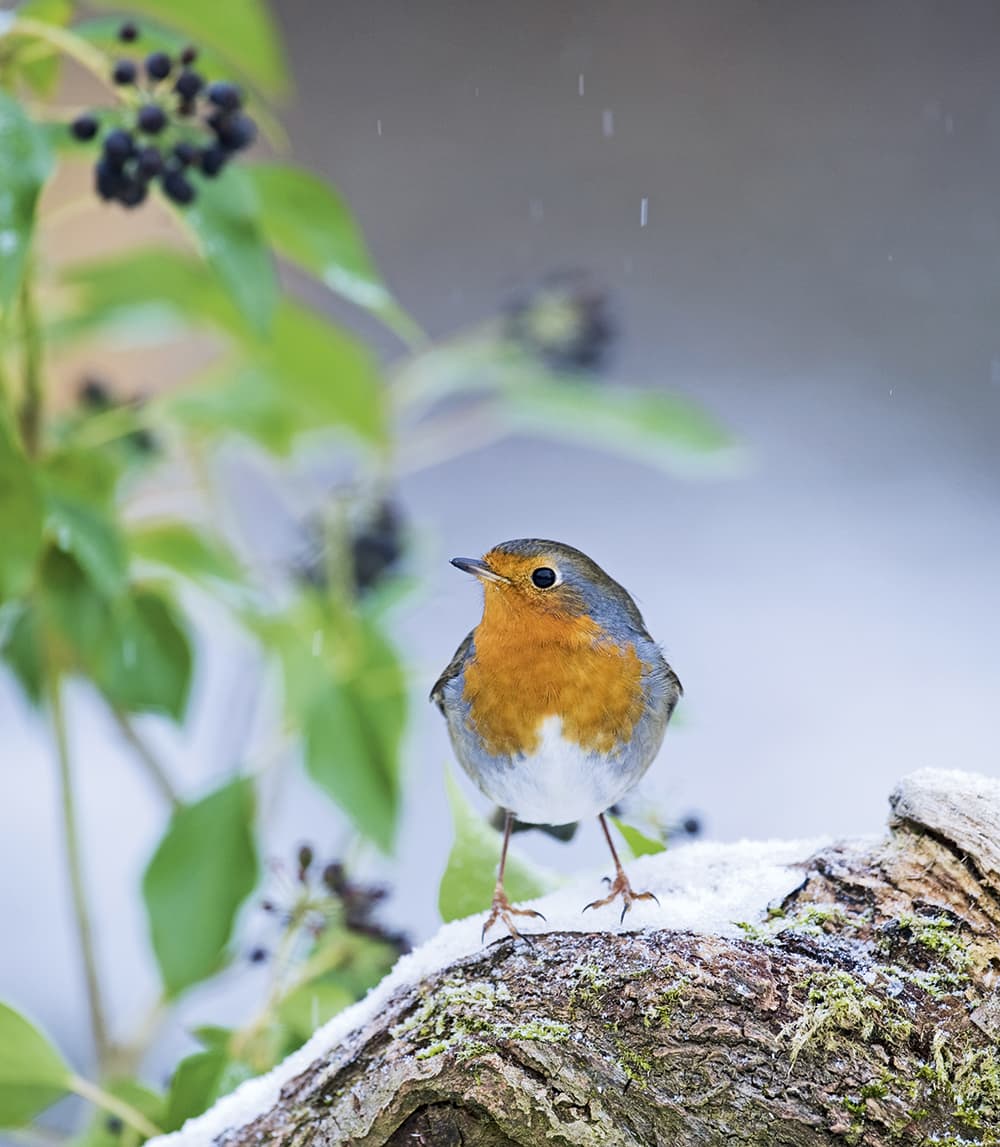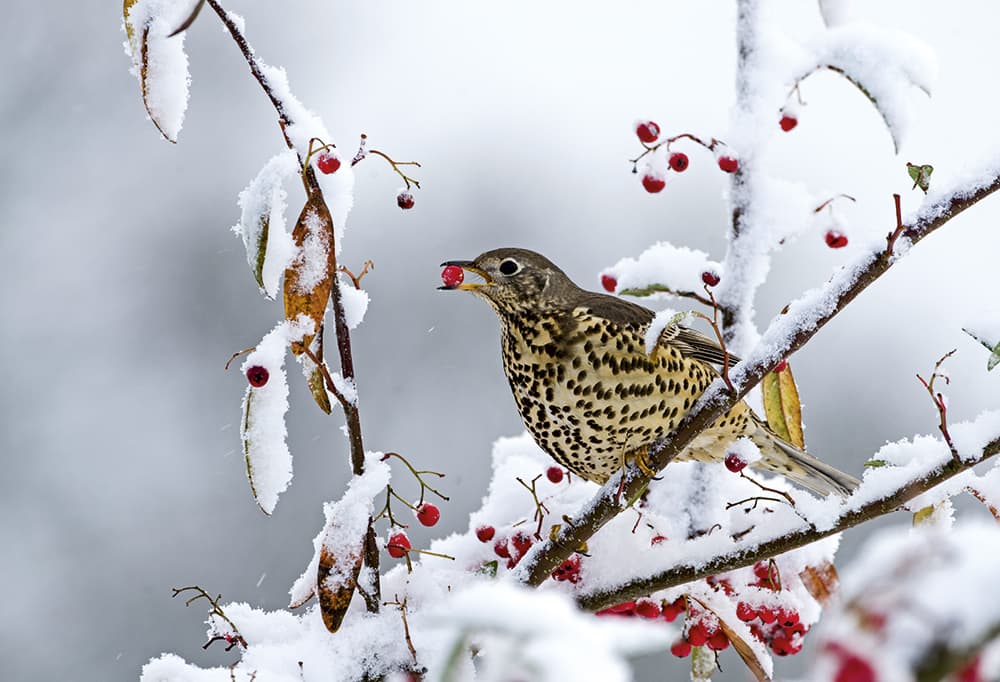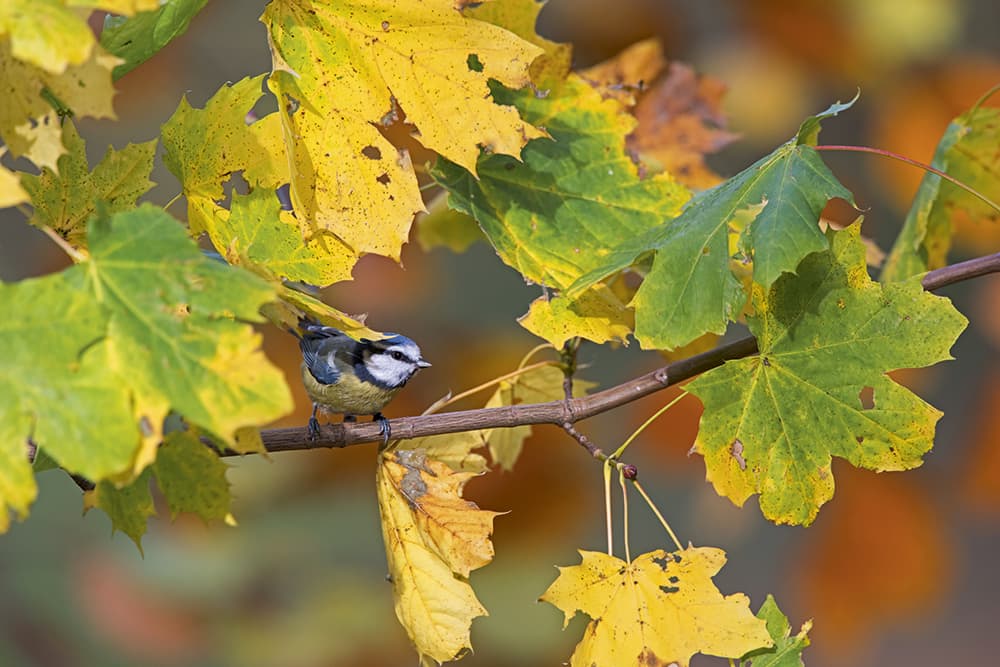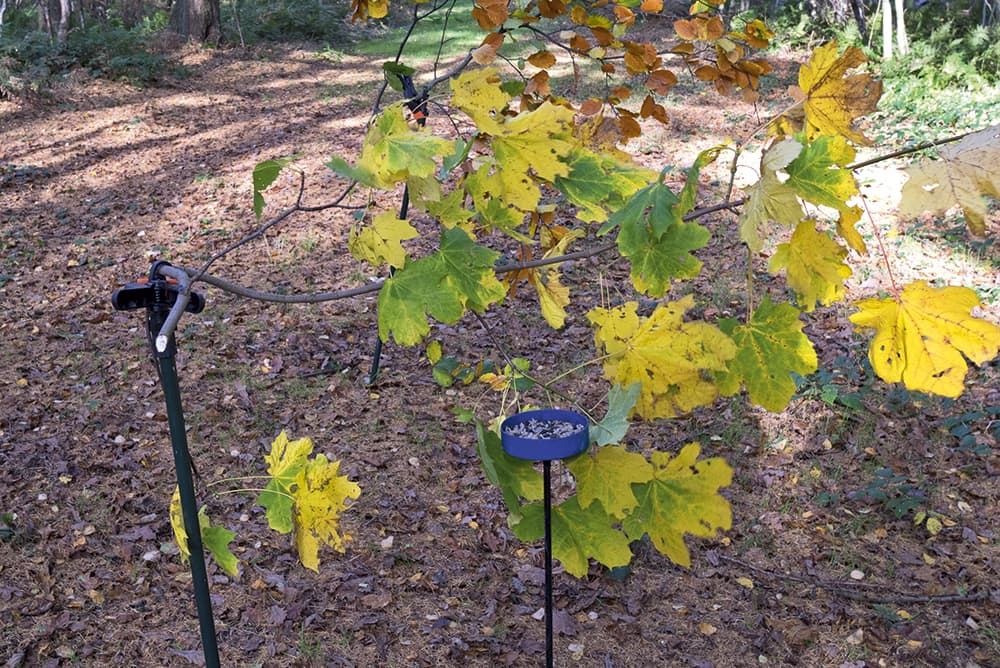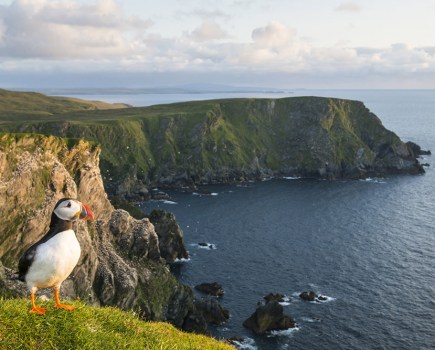
With a bit of planning, eye-catching shots can be made on your doorstep. This goldfinch was caught on a frosted teazel. All images by David Tipling.
It can be easy to ignore a photographic opportunity right under your nose, but rewarding wildlife photography can be enjoyed from your home. Many woodland bird species are challenging to approach in the countryside, but by providing food in your garden, eye-catching pictures can be made to look as if they were shot in a wild wood. If you don’t have a garden, chances are you may not live too far from a nature reserve with a feeding station, which can offer similar opportunities.
The first step is to set up a natural-looking perch close to your bird table or feeder, so visiting birds land on it before hopping onto the food. When positioning a perch, think about backgrounds and light. Your perch needs to be out of shot of the feeder. Ideally, you want the sun behind you at the time of day you are likely to photograph. This positioning may allow you to shoot into the light, too, for backlit shots and silhouettes. Mornings tend to be best for bird activity. Soon after dawn, especially after a cold night, your garden visitors will be refuelling and there should be plenty of activity.
Late autumn through to early spring is best. Numbers of birds visiting gardens tend to peak in late winter, when food availability in the countryside is at its lowest. It is then that the widest variety of species is likely to show up.
Get in range
Once everything is set up and the birds are pouring into your avian café, the next challenge is to be within range to photograph. A portable hide is the obvious choice, but budget options include simply photographing from the house or a shed. You could also make a hide out of weed-suppressing material. Build a frame and simply wrap the material around, making a door and cutting an opening for your lens. If you wish to sit back in comfort, a trigger release to fire your camera remotely is worth considering. There are plenty of relatively inexpensive options on the market.
If you struggle to get birds to land on a perch, it may be that it is too easy for them to fly straight onto the food. There are ways of making this trickier, although it may take some fiddling. I can sometimes spend a couple of hours re-aligning things and continually moving props and perches around. I sometimes tape an old film canister to a garden cane, or use a bird-feeding dish on a metal rod filled with food and placed below the branch on which I wish to photograph the bird. This works well as it is hard for birds to land on, and if there are a lot of birds they have to queue. The perch is then more likely to get used.
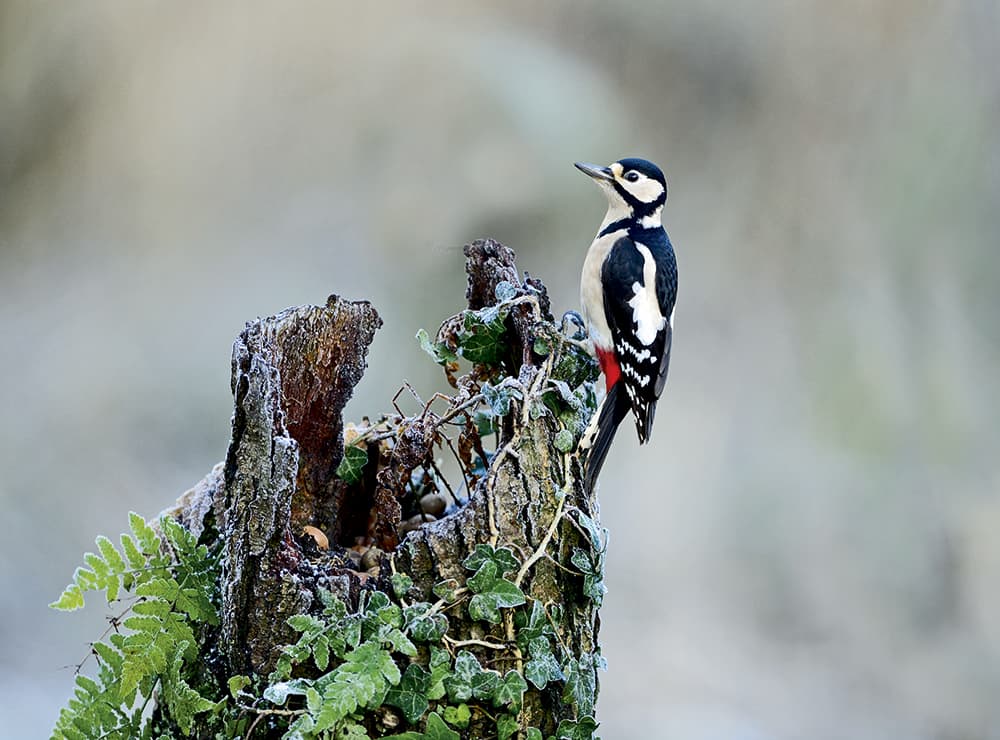
Drilling holes in old stumps and filling them with fat or nuts can draw in a host of birds, such as this great spotted woodpecker
Favoured spots
When observing birds coming in to feed, you will notice there are certain trees or bushes on which they loiter first. Try placing your perch on the same side so they have to land on the perch before the food. Once plenty of static shots have been bagged, it is tempting to try for some more dynamic images. Capturing small birds such as blue and coal tits in flight is challenging. One technique is to shoot as they fly from perch to feeder. If both are placed in the same plane of focus, you can manually focus your lens, have everything locked down on a tripod and simply fire the camera as soon as the bird twitches. Don’t look through the viewfinder as you will invariably be too slow – it’s better to use a trigger release so you can sit comfortably and concentrate. If you try often enough, you should get some successful shots.
Birds need to drink and bathe daily, so the provision of water can offer great opportunities too, especially at times when your feeders may be quiet. Keep water baths filled all year, as dry spells mean you should attract regular visitors. Even if birds don’t use it regularly, they will be aware of it and will visit when water is scarce.
In summer, some species, especially blackbirds, like sun bathing. It is worth introducing a patch of really fine dusty soil, as this may tempt them to dust bathe. They do this to rid themselves of mites, and a good range of species can be photographed in this way.
During midwinter, food is scarce. If it snows, robins, blackbirds and the normally shy mistle thrush will seek out bushes with berries. It is worth planting a berry-yielding bush if you don’t have one. Place a net over it in autumn to prevent the berries being eaten prematurely, then remove it when it snows. It will prove irresistible.
Set-up shot
For this shot, I placed a small food receptacle just below some attractive autumn foliage. I was careful to place it in such a position that visiting birds would tend to land among the leaves before hopping onto the food. The foliage from the sycamore branch is attached to a couple of old hide poles with a large Rolson nylon spring clamp to hold it firmly in place.
For the background, I placed a second branch from a beech tree behind to give a subtly different coloured backdrop. I decided to have the bird quite small in the frame to enhance the feel of autumn and the strong colours at this time of year.
David’s top tips
Photographing birds at a feeding station or drinking pool, whether you decide to set something up in your garden or out in the wider countryside, is fun and can be as simple or as challenging as you wish to make it.
Get your food choice right, making sure you cater for the birds you want to attract to your garden. Once they start appearing, make sure you top up feeding stations regularly to ensure their return.
Start simple, but you’ll find that the more you experiment with your set-ups and shots, the more ideas will develop for different images. For instance, backdrops can be old bed sheets sprayed in natural-looking greens or browns, while junk shops and car-boot sales can be a great source for finding props.
To kick things off, here are some useful tips and tricks.
Wide food choice
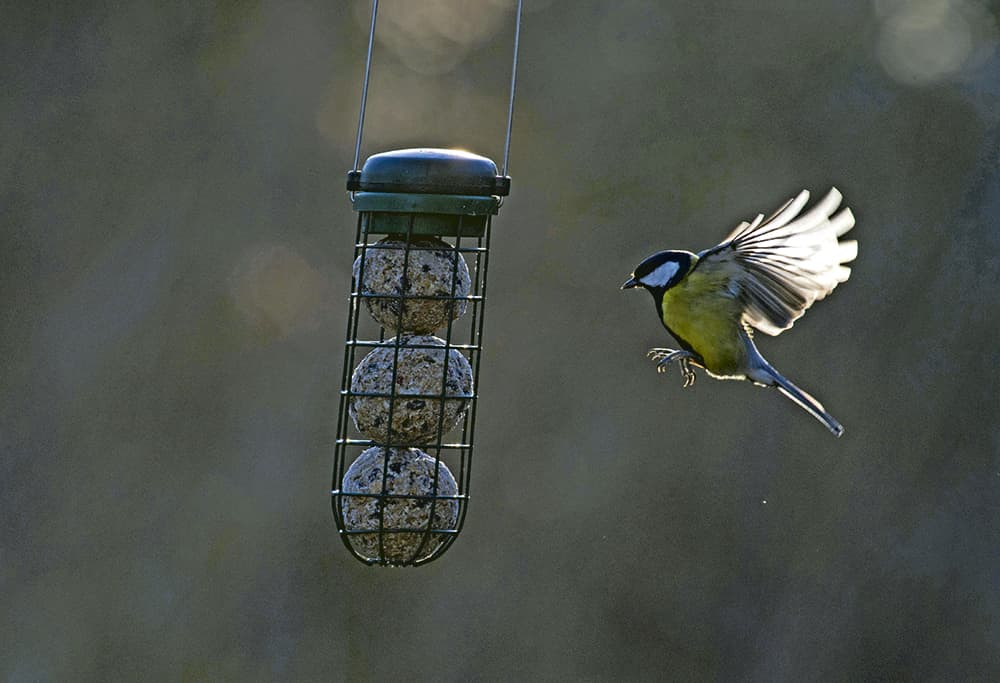
A wide food choice will attract a greater diversity of birds. Blackbirds and song thrushes love sultanas, while long-tailed tits and great spotted woodpeckers come to fat. Most tits will come to peanuts or seeds, while black sunflower seeds are a favourite of finches.
Use an upturned bin lid

If you want your garden visitors to drink or bathe, an upturned dustbin lid set into the ground is ideal. Put a brick or stones in the middle so the water is not too deep for the birds to bathe, and to make it look natural cover the sides with moss or bark.
Backgrounds

Try to have a clean background. This might mean keeping the perch and feeder sufficiently far from hedges or fences so that backgrounds can be out of focus. If this is a problem, and if you are handy at DIY, think of building a simple A-frame on which you can hang a backdrop.
Tell a story

Try to take advantage of the seasons, utilising autumn leaves, berries in winter, or blossom in spring. Props such as an old metal watering can, plant pots or a spade handle can convey a garden setting and help give a sense of place to the shot.
Bring out the drill
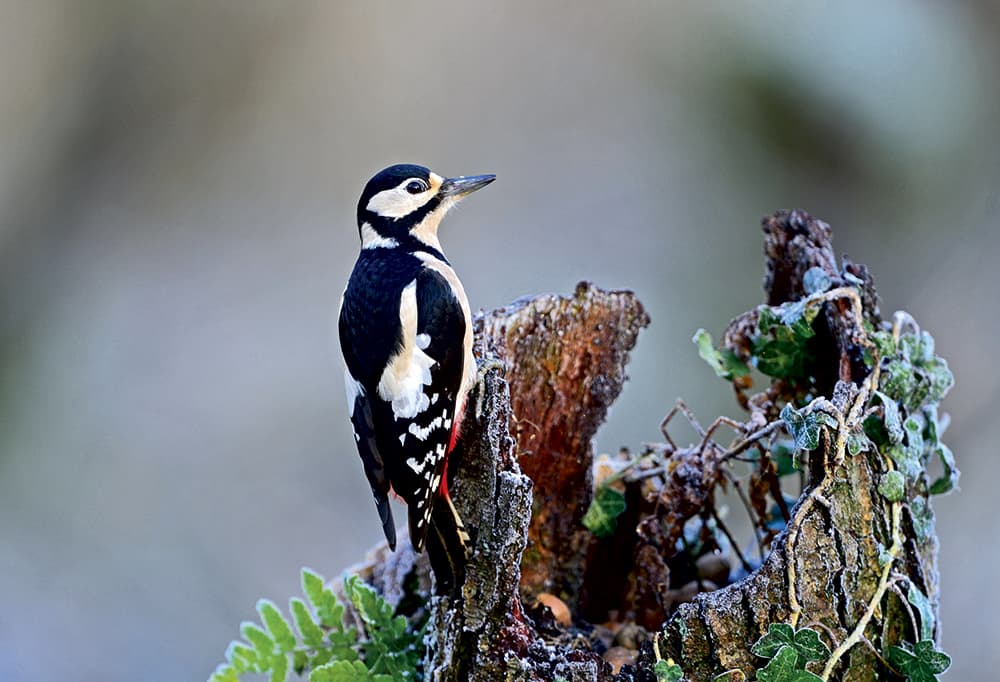
For birds that love fat and peanuts, try drilling into a log, then stuff fat or nuts into the holes. Food should be invisible to the camera to keep things looking natural. For natural goldfinch shots, see if you can collect some teasels and then sprinkle niger seeds over the heads.
Kit list
Telephoto lens
Use a telephoto lens with a range from 300mm upwards, with 500mm being ideal. A zoom lens is useful, particularly at drinking pools when birds of various sizes may appear.
Plastic spring clamps
Large plastic spring clamps are ideal for securing perches onto canes so you can place them near your feeder. Duct tape can be just as useful, too.
Reflector
I sometimes use a reflector to bounce light onto my subjects. This can be especially effective when shooting into the light, as it allows me to illuminate the side of the bird’s body that’s in shadow.
Remote trigger
A trigger-release system is a good investment for capturing images with wideangle lenses. Garden birds will quickly get used to a camera being placed close to a perch.
Portable hide
A portable hide gives you the freedom to set up in the optimum spot for light and backgrounds. Hunting blinds and bespoke photography hides come in all shapes and sizes. Expect to pay around £150 for a good one.



